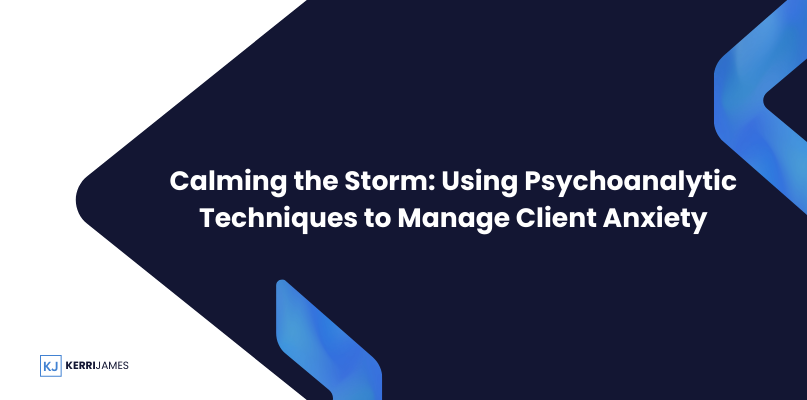The legal world, by its very nature, is often associated with stress, anxiety, and uncertainty. Clients facing legal challenges, whether navigating a complex lawsuit, a difficult divorce, a criminal charge, or even a seemingly straightforward business transaction, are often emotionally vulnerable and navigating turbulent waters. For legal professionals, the ability to manage client anxiety and cultivate a calm and reassuring environment is not just a valuable skill; it’s a crucial component of providing effective, compassionate, and client-centered legal representation. Psychoanalytic techniques, drawing upon a deep understanding of human behavior, emotions, and the unconscious mind, offer valuable insights into the nature of anxiety and provide practical tools for understanding, addressing, and alleviating client distress. By incorporating these techniques into their daily practice, legal teams can foster a sense of safety and trust, build stronger client relationships based on empathy and understanding, and ultimately, achieve more positive outcomes for their clients and their firm. This article explores the powerful intersection of psychoanalysis and client management, providing legal professionals with practical strategies, real-world examples, and ethical considerations to create a more calming, supportive, and empowering experience for their clients.
Understanding the Roots of Client Anxiety: A Deeper Dive into the Psychoanalytic Perspective
Anxiety, an inherent and often unavoidable part of the human experience, is frequently amplified and intensified when individuals face legal challenges. The uncertainty of the outcome, the potential financial ramifications, the fear of judgment or social repercussions, the emotional toll of legal proceedings, and the inherent power imbalance in the attorney-client relationship can all contribute to a perfect storm of anxiety and distress. Psychoanalytic theory, with its focus on the unconscious mind and the complex interplay of psychological factors, offers invaluable insights into the underlying causes and dynamics of anxiety, providing a framework for understanding and addressing client concerns with greater empathy, sensitivity, and effectiveness.
The Unconscious Mind: Unveiling the Hidden Depths of Fears and Anxieties: Psychoanalysis emphasizes the profound influence of the unconscious mind in shaping our thoughts, feelings, behaviors, and reactions to challenging situations. Often, client anxiety stems from unconscious fears, past experiences, unresolved conflicts, or deeply ingrained beliefs and assumptions that may not be immediately apparent to either the client or the attorney. By exploring these underlying dynamics through careful listening, empathetic questioning, and an understanding of psychological defense mechanisms, legal professionals can gain a deeper and more nuanced understanding of the client’s emotional landscape, tailoring their approach to address not just the legal issues at hand but also the emotional undercurrents that often drive client behavior and decision-making.
Defense Mechanisms: Recognizing the Protective Strategies of the Psyche: When confronted with anxiety-provoking situations, the ego, the part of the psyche responsible for mediating between the internal world and external reality, employs defense mechanisms to protect the individual from overwhelming emotional distress. These mechanisms, while often adaptive in the short term, can sometimes hinder open communication, create resistance to legal advice, and obstruct the formation of a trusting attorney-client relationship. Recognizing common defense mechanisms, such as denial, repression, projection, rationalization, intellectualization, and displacement, can provide legal professionals with valuable insights into client reactions, enabling them to tailor their communication and approach to address the underlying anxieties more effectively and build a stronger therapeutic alliance.
Transference (Revisited): Navigating the Complexities of Projected Emotions: Transference, a cornerstone of psychoanalytic theory, refers to the unconscious projection of feelings, expectations, and relational patterns from past relationships onto individuals in the present. In the legal context, clients may unconsciously project their anxieties, fears, or past experiences with authority figures, such as parents, teachers, or other figures who held power or influence in their lives, onto their attorney. Understanding and addressing these transference dynamics with sensitivity, awareness, and clear communication is paramount for managing client anxiety, building trust, and fostering a productive and collaborative working relationship.
Practical Techniques for Managing Client Anxiety: Creating a Calm and Reassuring Experience
Creating a Safe and Containing Space: The Foundation of Trust and Openness: The cornerstone of managing client anxiety is creating a safe, supportive, and emotionally containing environment where clients feel comfortable expressing their vulnerabilities, anxieties, and concerns without fear of judgment or dismissal. This begins with the physical space itself – a comfortable and welcoming office, a private and confidential meeting room, and a calm and reassuring atmosphere free from distractions or interruptions. It extends to the attorney’s demeanor – a calm, empathetic presence, attentive listening, a non-judgmental attitude, and genuine respect for the client’s emotional experience. This safe space fosters trust, encourages open communication, and allows clients to feel heard, understood, and validated, paving the way for a more productive and collaborative attorney-client relationship.
Active Listening and Empathetic Validation: Hearing the Unspoken, Feeling the Unfelt: Active listening is more than just hearing words; it’s a conscious and deliberate process of fully engaging with the client’s message, both verbal and nonverbal, to understand their perspective, emotions, and underlying needs. Reflecting back their concerns, summarizing their key points, using empathetic statements like “I understand this is a difficult time for you” or “I can see why you’re feeling anxious,” and acknowledging their emotional experience can validate their feelings, build rapport, and create a stronger therapeutic alliance.
Clear and Concise Communication: Providing Clarity and Reducing Uncertainty: Uncertainty is a major driver of anxiety. Providing clients with clear, concise, and accurate information about their case, the legal process, their options, potential outcomes, and realistic timelines can significantly reduce anxiety, empower them to make informed decisions, and foster a sense of control and agency in a situation that often feels overwhelming and unpredictable. Avoid using legal jargon or complex terminology that might confuse or overwhelm the client. Explain legal concepts in simple, understandable language, using metaphors or analogies if helpful, and be patient in answering their questions thoroughly and honestly, addressing their specific concerns and anxieties.
Reframing (Revisited): Shifting Perspectives to Empower and Create Possibilities: Reframing, a core NLP technique, involves helping clients shift their perspective on their situation, transforming perceived negatives into positives, exploring alternative interpretations, and focusing on potential solutions rather than dwelling on problems. For example, a client anxious about an upcoming deposition might be helped to reframe the experience not as a terrifying interrogation but as an opportunity to tell their story, present their side of the case, and contribute to a positive resolution.
Managing Expectations: Setting Realistic Goals and Navigating Uncertainties: Unrealistic expectations, often fueled by fear, desperation, or past experiences, can significantly contribute to client anxiety. Attorneys should exercise caution in their language, avoiding making promises they cannot keep or creating unrealistic expectations about the outcome of the case. Clearly and honestly communicate the potential challenges, the inherent uncertainties of the legal process, and the range of possible outcomes, while also emphasizing your commitment to working diligently on their behalf, advocating for their best interests, and providing support and guidance throughout the legal journey.
Real-World Examples of Managing Client Anxiety: Practical Applications in Legal Settings
Scenario: A client facing a complex and contentious divorce is overwhelmed with anxiety about the future, expressing fears about financial insecurity, the impact on their children, and the potential loss of their home and social standing.
- Intervention: The attorney begins by creating a safe and supportive environment for the client to express their anxieties and fears without judgment. They actively listen to the client’s concerns, validating their feelings and acknowledging the difficulty and emotional toll of divorce. The attorney provides clear and concise information about the divorce process, including child custody arrangements, spousal support calculations, property division laws, and the potential range of outcomes. They work collaboratively with the client to develop a realistic and achievable plan for navigating the legal and emotional challenges of the divorce, focusing on securing their financial future, protecting their relationship with their children, and minimizing the disruption to their lives. The attorney may also provide referrals to therapists, support groups, or financial advisors to address the client’s emotional and practical needs comprehensively.
Scenario: A client charged with a serious crime is experiencing intense anxiety about the potential consequences, including the possibility of jail time, damage to their reputation, and the impact on their family and career.
- Intervention: The attorney recognizes the client’s heightened anxiety and responds with empathy, understanding, and reassurance. They clearly explain the legal process, the potential outcomes of the case, and the specific strategies they will employ to defend the client’s rights and achieve the best possible outcome. The attorney helps the client manage their anxiety by focusing on the present, breaking down the legal process into manageable steps, emphasizing the importance of staying engaged and informed, and providing regular updates on the case’s progress. Recognizing the significant emotional toll of criminal charges, the attorney also connects the client with resources for emotional and psychological support, such as therapists, counselors, or support groups specializing in legal-related stress and anxiety.
Scenario: A client involved in a high-stakes business dispute is experiencing debilitating anxiety about the financial implications of the lawsuit, the potential impact on their business and employees, and the uncertainty of the outcome.
- Intervention: The attorney actively listens to the client’s concerns, validating their anxieties about the financial risks, the potential disruption to their business operations, and the uncertainty surrounding the outcome of the litigation. The attorney provides clear and concise explanations of the legal strategies being employed, the potential timelines for the case, the range of possible outcomes, and the steps being taken to mitigate risks and protect the client’s interests. They work collaboratively with the client to develop a comprehensive plan for managing the financial and operational aspects of their business during the legal proceedings, minimizing disruption, exploring alternative dispute resolution options, and maximizing their chances of achieving a favorable outcome. The attorney also recognizes the importance of emotional support and may offer referrals to therapists, business coaches, or support networks for entrepreneurs facing similar challenges.
Scenario: A client seeking immigration assistance is experiencing significant anxiety due to the complexities of immigration law, the uncertainty of their status, and the potential for deportation.
- Intervention: The attorney understands the unique anxieties and vulnerabilities faced by immigration clients and creates a safe and supportive environment where the client feels comfortable sharing their fears and concerns. They explain the immigration process clearly and concisely, outlining the relevant laws, regulations, and procedures, and providing realistic expectations about timelines and potential outcomes. The attorney emphasizes their commitment to advocating for the client’s rights, providing regular updates on the case’s progress, and offering emotional support and reassurance throughout the often lengthy and stressful immigration process. They may also connect the client with community resources, support groups, or mental health professionals specializing in immigration-related stress and trauma.
Integrating Psychoanalytic Techniques into Your Legal Practice: A Client-Centered Approach
Integrating psychoanalytic principles and techniques into your firm’s client management practices requires a commitment to ongoing learning, self-reflection, and a client-centered approach that prioritizes not just legal expertise but also the emotional well-being of your clients.
- Continuing Education in Psychoanalytic Principles and Their Application in Legal Settings: Invest in continuing education opportunities for your legal team, including workshops, seminars, online courses, and professional development programs that explore the application of psychoanalytic principles in legal contexts. These programs should provide practical training in active listening, empathy, communication skills, recognizing and managing transference and countertransference, and ethical considerations in applying psychoanalytic insights to client interactions.
- Supervision and Consultation: Supporting Your Team’s Emotional Well-being: Provide regular supervision and consultation opportunities for attorneys and other legal professionals to discuss challenging client interactions, explore potential transference and countertransference issues, gain insights into their own emotional responses to client anxieties, and develop effective strategies for managing complex client dynamics. Supervision can be provided by experienced colleagues, mentors, or external mental health professionals with expertise in legal settings.
- Self-Reflection and Mindfulness Practices: Cultivating Emotional Intelligence: Encourage self-reflection and mindfulness practices among your team. Journaling, meditation, mindfulness exercises, or simply taking a few moments each day to reflect on client interactions can enhance self-awareness, improve emotional regulation, reduce stress and burnout, and cultivate greater empathy and compassion in client interactions. By understanding and managing their own emotional responses, legal professionals can better support their clients’ emotional well-being and navigate challenging interactions with greater skill and sensitivity.
- Interdisciplinary Collaboration: Bridging the Gap Between Law and Mental Health: Foster collaboration between legal professionals and mental health professionals. Inviting therapists, counselors, or psychologists to provide training or consultation to your team can deepen their understanding of psychological dynamics, enhance their ability to recognize and respond to client emotional needs, and provide valuable resources for clients requiring specialized support beyond the scope of legal representation. This interdisciplinary approach recognizes the interconnectedness of legal and emotional well-being and provides a more holistic and client-centered approach to legal practice.
Measuring the Impact of Anxiety Management Techniques: Demonstrating the Value of a Client-Centered Approach
While the impact of psychoanalytic techniques and anxiety management strategies can be subtle and challenging to quantify directly, certain key metrics can provide valuable insights into their effectiveness in enhancing the client experience and improving overall firm performance:
- Client Satisfaction Surveys: Gathering Feedback and Identifying Areas for Improvement: Regularly assess client satisfaction through surveys, feedback forms, and client interviews. Specifically inquire about their experience with communication, empathy, support, the level of anxiety they experienced throughout the legal process, and their overall satisfaction with their legal representation. Analyze this feedback to identify areas for improvement, refine your approach to client management, and demonstrate the value of your firm’s commitment to client well-being.
- Client Retention Rates: A Key Indicator of Client Loyalty and Trust: Track client retention rates over time and analyze any correlation between improved anxiety management practices and increased client loyalty. If your efforts to create a calmer and more supportive experience are effective, you should see a higher percentage of clients returning for future legal needs and recommending your firm to others.
- Positive Client Testimonials and Referrals: The Power of Word-of-Mouth Marketing: Monitor the number of positive client testimonials and referrals received. An increase in positive feedback and word-of-mouth marketing can be a strong indicator of client satisfaction, trust, and the positive impact of your firm’s client-centered approach. Positive testimonials can also be leveraged as powerful marketing tools, showcasing your firm’s commitment to client well-being and differentiating you from competitors.
- Case Outcomes and Efficiency: The Benefits of a Collaborative Approach: While not solely attributable to anxiety management techniques, improved communication, trust, and cooperation between attorney and client, fostered by a supportive and empathetic approach, can contribute to more efficient case management, smoother negotiations, and potentially more favorable case outcomes. Tracking these metrics can provide valuable insights into the overall impact of your client-centered approach on your firm’s success.
Final Words: The Human Element in Legal Practice: Empathy, Connection, and Positive Outcomes
The attorney-client relationship is far more than a simple exchange of legal services; it’s a human connection, often layered with complex emotions, unspoken anxieties, and deeply personal experiences. In the legal profession, where clients frequently face situations involving fear, uncertainty, and high stakes, empathy and understanding can be as important as legal expertise. By recognizing the profound influence of anxiety on client behavior and decision-making, attorneys can deepen their client relationships, provide more effective guidance, and help clients navigate legal challenges with greater confidence.
Integrating insights from psychoanalytic theory, such as an understanding of anxiety and defense mechanisms, enables attorneys to approach client interactions with greater sensitivity. Clients may present as resistant, overly cautious, or highly emotional in ways that can sometimes be puzzling without understanding the underlying emotional dynamics. For instance, a client’s reluctance to settle may not be due to a lack of trust in the attorney’s advice but rather a manifestation of fear or an unconscious need for validation. Recognizing these drivers allows attorneys to address clients’ concerns in a way that resonates with their emotional needs, rather than merely focusing on logic or legal facts.
Psychoanalytic techniques, such as active listening, empathy, and the recognition of transference, provide tools for building more trusting and constructive attorney-client relationships. Active listening involves giving clients full attention and validating their feelings, which can help clients feel genuinely heard and understood. This process reduces client anxiety and opens the door to more honest and collaborative communication. By addressing not just the legal aspects of a case but also the emotional dimensions, attorneys can create an environment where clients feel safe expressing their true concerns and priorities.
Prioritizing the human element in legal practice also enhances the attorney’s ability to communicate effectively. When attorneys approach clients with empathy and a commitment to understanding their unique perspectives, they can tailor their communication styles accordingly. For example, a highly analytical client might respond better to structured, data-driven explanations, while a more emotionally driven client may need compassionate reassurance. This individualized approach to communication fosters trust and strengthens the attorney-client bond, making clients more likely to stay engaged in the legal process and follow through on important decisions.
Embracing these complexities goes beyond individual client interactions; it helps cultivate a firm culture that values empathy, client-centered service, and well-being. Attorneys who understand and appreciate the human element of their practice are more likely to find fulfillment in their work, as they see firsthand the positive impact of their support on clients’ lives. This approach not only elevates the quality of representation but also contributes to a supportive, cohesive work environment that can reduce burnout and foster long-term professional satisfaction.
In sum, integrating the human element into legal practice is not merely an enhancement; it is a foundation for building a more empathetic, supportive, and effective legal service. By prioritizing client well-being and embracing the complexities of human interaction, attorneys can create a client-centered experience that fosters trust, loyalty, and positive outcomes. This approach strengthens client relationships, contributes to firm success, and redefines the role of an attorney as a compassionate guide through both legal and emotional challenges.










